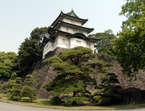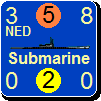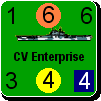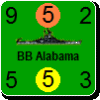yvesp
Posts: 2083
Joined: 9/12/2008
Status: offline

|
Made a pass on everything on the map, trying to remember where I was.
Of course, Germany is doomed; it cannot act and is not a threat. There are enough troops already there to finish it off; well bad dice can always change that, but even with bad dice, nothing wrong can really happen.
On the Japanese side, things are not so good for the allies.
In Japan itself, there are:
* 11 full corps and some divisions in addition, many of them of good quality
* 5 NAVs, 3 FTR: the imperial air force is not yet done with
* A still rather large navy, outclassed by the allied fleets, but which could still disrupt allied operations given luck
* enough oil for all of this to operate fully at least 2 times
In China, the Japanese army is impressive, but rather teethless: it has a difficult time keeping supply opened to Japan. Yet, the allies will have trouble permanently cutting the supply, given the number of convoys that the Japanese still have. However, it is smaller in number than the Chinese army, and the north front is shaky; a rout is not unlikely considering the supply problems.
The western allies have about 17 corps between both China seas. Worse, the 12 naval transports are widely spread. Clearly, the allies are not ready for more than opportunity actions. The allied fleets outclass the Japanese fleet, but we all know how misleading that can be. A small naval raid can sometimes be devastating; keeping supply open is of paramount importance. If the supply bugs have been solved however, supply should be able to run from Paris (a primary supply source for both the Commonwealth and USA) to Korea and Mandchuria through Russia with no possibility for the Japanese to interfere: keeping the naval lanes open is thus not highly important, except in the North China sea. This was a primary reason for the invasion of Korea in the first place.
The allies planes are not very numerous, 4 FTR and 3 heavy bombers, but more are on the way which should arrive shortly: the allies don't yet fully control the skies, but this should change shortly. More to the point, the Japanese are not likely to engage their air assets lightly, first because they lack oil, second because they could run the risk of having their oil reserves bombed... One should note however that the allied FTR outclass most Japanese planes. The sole Japanese plane that can stand its own is the Ki-84-lb (rating 8); but it faces 2 P51D (rating 8), 1 P38L and 1 F6F3 (rating 7), soon to be joined by two black widows and Spitfires IX. The other Japanese FTR have poor ratings of 6 and 5...
As objectives go, Japan still controls Batavia, Saigon, Shangai, Manila, Truk, Kawalain, all objectives in Japan. Clearly, the allies will want to reduce this number, and as the military situation clearly doesn't allow for a successful conquest of Japan within time, the allies will concentrate on keeping Japan in check, while they will conduct peripheral operations hopefully undisturbed while conveying as many reinforcements as possible. A reasonable expectation is to conquer all objectives outside of Japan by the end of the war.
|
 Printable Version
Printable Version





























 New Messages
New Messages No New Messages
No New Messages Hot Topic w/ New Messages
Hot Topic w/ New Messages Hot Topic w/o New Messages
Hot Topic w/o New Messages Locked w/ New Messages
Locked w/ New Messages Locked w/o New Messages
Locked w/o New Messages Post New Thread
Post New Thread